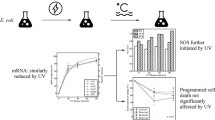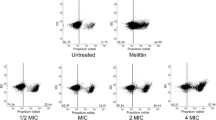Abstract
Escherichia coli cells have been observed earlier to display caspase-3-like protease activity (CLP) and undergo programmed cell death (PCD) when exposed to gamma rays. The presence of an irreversible caspase-3 inhibitor (Ac-DEVD-CMK) during irradiation was observed to increase cell survival. Since radiation is known to induce SOS response, the effect of a caspase-3 inhibitor on SOS response was studied in E. coli. UV, a well-known SOS inducer, was used in the current study. Cell filamentation in E. coli upon UV exposure was found to be inhibited by ninefold in the presence of a caspase-3 inhibitor. CLP activity was found to increase twofold in UV-exposed cells than in control (non-treated) cells. Further, bright fluorescing filaments were observed in UV-exposed E. coli cells treated with FITC-DEVD-FMK, a fluorescent dye tagged with an irreversible caspase-3 inhibitor (DEVD-FMK), indicating the presence of active CLP in these cells. Unlike caspase-3 inhibitor, a serine protease inhibitor, phenylmethanesulfonyl fluoride (PMSF), was not found to improve cell survival after UV treatment. Additionally, a SOS reporter system known as SIVET (selectable in vivo expression technology) assay was performed to reconfirm the inhibition of SOS induction in the presence of caspase-3 inhibitor. SIVET assay is used to quantify cells in which the SOS response has been induced leading to a scorable permanent selectable change in the cell. The SIVET induction frequency (calculated as the ratio of SIVET-induced cells to total viable cells) increased around tenfold in UV-exposed cultures. The induction frequency was found to decrease significantly to 51 from 80% in the cells pre-incubated with caspase-3 inhibitor. On the contrary, caspase-3 inhibitor failed to improve cell survival of E. coli ΔrecA and E. coli DM49 (SOS non-inducible) cells post UV treatment. Summing together, the results indicated a possible linkage of SOS response and the PCD process in E. coli. The findings also indicated that functional SOS pathway is required for CLP-like activity; however, the exact mechanism remains to be elucidated.





Similar content being viewed by others
References
Al Mamun AA, Gautam S, Humayun MZ (2006) Hypermutagenesis in mutA cells is mediated by mistranslational corruption of polymerase, and is accompanied by replication fork collapse. Mol Microbiol 62:1752–1763
Autret S, Levine A, Holland IB, Seror SJ (1997) Cell cycle checkpoints in bacteria. Biochimie 79:549–554
Baba T, Ara T, Hasegawa M, Takai Y, Okumura Y, Baba M, Datsenko KA, Tomita M, Wanner BL, Mori H (2006) Construction of Escherichia coli K-12 in-frame, single-gene knockout mutants: the Keio collection. Mol Syst Biol 2:1–11
Bayles KW (2014) Bacterial programmed cell death: making sense of a paradox. Nat Rev Microbiol 12:63–69
Bos J, Yakhnina AA, Gitai Z (2012) BapE DNA endonuclease induces an apoptotic-like response to DNA damage in Caulobacter. Proc Natl Acad Sci U S A 109:18096–18101
Daly MJ (2009) A new perspective on radiation resistance based on Deinococcus radiodurans. Nat Rev Microbiol 7:237–245
Dwyer DJ, Camacho DM, Kohanski MA, Callura JM, Collins JJ (2012) Antibiotic-induced bacterial cell death exhibits physiological and biochemical hallmarks of apoptosis. Mol Cell 46:561–572
Erental A, Sharon I, Engelberg-Kulka H (2012) Two programmed cell death systems in Escherichia coli: an apoptotic-like death is inhibited by the mazEF-mediated death pathway. PLoS Biol 10:e1001281
Gautam S, Sharma A (2002a) Rapid cell death in Xanthomonas campestris pv. glycines. J Gen Appl Microbiol 48:67–76
Gautam S, Sharma A (2002b) Involvement of caspase-3-like protein in rapid cell death of Xanthomonas. Mol Microbiol 44:393–401
Gautam S, Kalidindi R, Humayun MZ (2012) SOS induction and mutagenesis by dnaQ missense alleles in wild type cells. Mutat Res 735:46–50
Ghosal D, Trambaiolo D, Amos LA, Löwe J (2014) MinCD cell division proteins form alternating co-polymeric cytomotive filaments. Nat Commun 5:5341
Janion C (2008) Inducible SOS response system of DNA repair and mutagenesis in Escherichia coli. Int J Biol Sci 4:338–344
Kreuzer KN (2013) DNA damage responses in prokaryotes: regulating gene expression, modulating growth patterns, and manipulating replication forks. Cold Spring Harb Perspect Biol 5(11):a012674
Kuzminov A (1999) Recombinational repair of DNA damage in Escherichia coli and bacteriophage lambda. Microbiol Mol Biol Rev 63:751–813
Livny J, Friedman DI (2004) Characterizing spontaneous induction of Stx encoding phages using a selectable reporter system. Mol Microbiol 51:1691–1704
Michel B (2005) After 30 years of study, the bacterial SOS response still surprises us. PLoS Biol 3:e255
Mount DW, Low KB, Edmiston SJ (1972) Dominant mutations (lex) in Escherichia coli K-12 which affect radiation sensitivity and frequency of ultraviolet light-induced mutations. J Bacteriol 112:886–893
Peeters SH, Jonge M (2018) For the greater good: programmed cell death in bacterial communities. Microbiol Res 207:161–169
Saxena S, Gautam S, Maru G, Kawle D, Sharma A (2012) Suppression of error prone pathway is responsible for antimutagenic activity of honey. Food Chem Toxicol 50:625–633
Thi TD, López E, Rodríguez-Rojas A, Rodríguez-Beltrán J, Couce A, Guelfo JR, Castañeda-García A, Blázquez J (2011) Effect of recA inactivation on mutagenesis of Escherichia coli exposed to sublethal concentrations of antimicrobials. J Antimicrob Chemother 66:531–538
Wadhawan S, Gautam S, Sharma A (2010) Metabolic stress-induced programmed cell death in Xanthomonas. FEMS Microbiol Lett 312:176–183
Wadhawan S, Gautam S, Sharma A (2013) A component of gamma radiation induced cell death in E. coli is programmed and interlinked with activation of caspase-3 and SOS response. Arch Microbiol 195:545–557
Wadhawan S, Gautam S, Sharma A (2014a) Involvement of proline oxidase (PutA) in programmed cell death of Xanthomonas. PLoS One 9:e96423
Wadhawan S, Gautam S, Sharma A (2014b) Bacteria undergo programmed cell death upon low dose gamma radiation exposure. Int J Curr Microbiol App Sci 12:276–283
Yun DG, Lee DG (2016) Antibacterial activity of curcumin via apoptosis-like response in Escherichia coli. Appl Microbiol Biotechnol 100:5505–5514
Zgur-Bertok D (2013) DNA damage repair and bacterial pathogens. PLoS Pathog 9:e1003711
Acknowledgements
The authors acknowledge Keio collection, Japan, for E. coli wt and recA knockout strains provided to our institute (Bhabha Atomic Research Centre, Mumbai, India) and Dr. S. H. Mangoli (Molecular Biology Division, B.A.R.C, Mumbai) for sharing these strains with us. The authors thank Dr. Anubrata Das (Molecular Biology Division, B.A.R.C, Mumbai) for sharing E. coli DM49 strain with us. The authors also acknowledge Prof. M. Z. Humayun (Rutgers New Jersey Medical School, New Jersey, USA) for gifting us E. coli MG1655 and E. coli SG104 strains.
Author information
Authors and Affiliations
Corresponding author
Additional information
Publisher’s note
Springer Nature remains neutral with regard to jurisdictional claims in published maps and institutional affiliations.
Electronic supplementary material
Figure S1
General scheme of SIVET assay (adapted from Livny and Friedman, 2004).Selectable in vivo expression technology (SIVET) system consists of two main components: (a) a gene encoding the TnpR resolvase inserted downstream of a defective H-19B prophage, and (b) a chloramphenicol transacetylation gene (cat) disrupted by tetracycline (tet) gene. This tet gene is flanked by a modified resolvase target sequence (resC). During SOS induction, the prophage promoter is de-repressed and the resulting activity of resolvase excises the tet gene and one resC site. Excision results in a DNA fragment with tet gene (it is eventually lost during segregation) and a sequence with functional cat gene converting the cell from TetR CmS phenotype to a TetS CmR phenotype. Therefore, the ratio of CmR cells to total viable cells is a measure of prophage induction, which is indicative of SOS response. (PNG 816 kb)
Figure S2
Cell morphology ofE. coliΔrecAand DM49 cells after UV exposure (70 mJ m−2 s−1). Crystal violet stained (A)E. coli ΔrecA control cells (no UV treatment); (B)E. coli ΔrecA cells treated with UV for 6 s; (C)E. coli ΔrecA cells treated with UV for 12 s; (D)E. coli DM49 control cells (no UV treatment); (E)E. coli DM49 cells treated with UV for 12 s. Cells were examined under a microscope (Carl Zeiss, Germany) using oil immersion objective (100X). (PNG 4393 kb)
Rights and permissions
About this article
Cite this article
Wadhawan, S., Gautam, S. Rescue of Escherichia coli cells from UV-induced death and filamentation by caspase-3 inhibitor. Int Microbiol 22, 369–376 (2019). https://doi.org/10.1007/s10123-019-00060-w
Received:
Revised:
Accepted:
Published:
Issue Date:
DOI: https://doi.org/10.1007/s10123-019-00060-w




